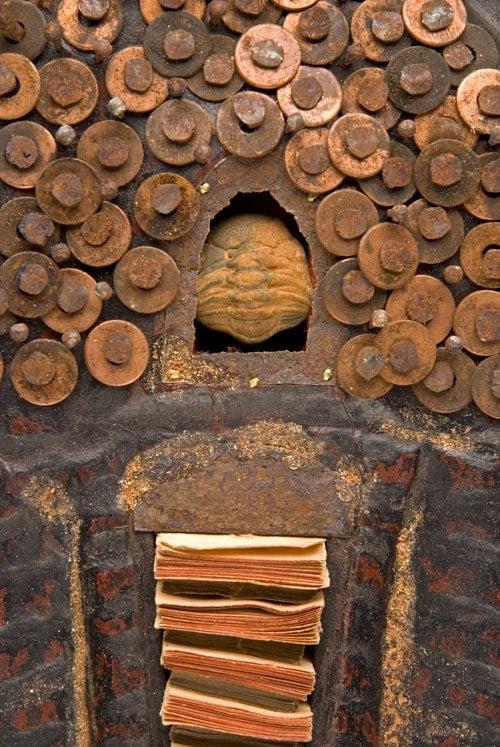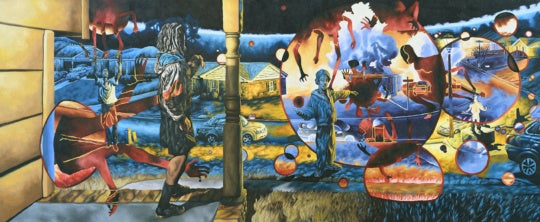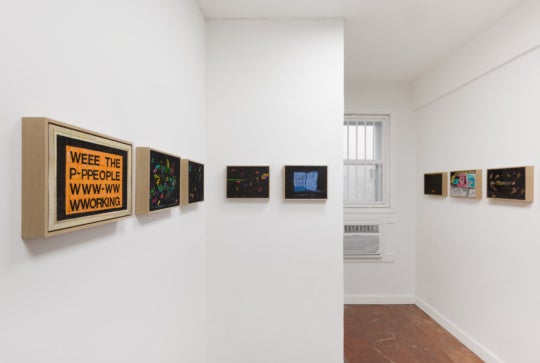
Jane Garver, one of Idea Capital’s new grant recipients, and artist Kelly Kristin Jones discuss Garver’s experiences in artist residency programs as well as her upcoming project, the creation of a “Process Residency” in conjunction with MINT Gallery, which will allow a visiting artist to work and form partnerships with other creatives in the Atlanta area. Rachel Simone James, a sound-based artist from New York City, was recently announced as the Process Residency recipient. James’s residency will take place at MINT from May 1 through May 17, during which time the artist will utilize the gallery’s space as a working studio.
Jones visited with Garver in her studio at the Atlanta Contemporary Art Center, where she has had a space since September.
Kelly Kristin Jones: I know from reading about you and from seeing your various exhibitions and installations that you’re a performer, a sound artist, a painter, and that you’ve also done public art and mural work. So, how do you use this small studio space? Do all of those art forms come into play here?
Jane Garver: I definitely use this space to get administrative tasks done. Most of the time, what I’m doing in here is writing applications, thinking about something that I’ve already written, note-taking, and a little bit of idea sketching. It would be really awesome to say that my fall was a really sexy time where I was using all of these materials in this new studio space, but actually, this past fall was a crazy one because I went on several residencies.
KKJ: It sounds like this place serves as both a creative laboratory and a kind of retreat for you?
JG: I would say that it shifts a lot. I think that whatever project I’m working on at a given time really dictates how I use the space. Things move around and I can set up the studio in different ways to be most useful. So lately, I’ve been editing sound and working on that here.
KKJ: You’ve had some really great experiences outside of Atlanta. You mentioned participating in several artist residencies in the fall. Do you see this studio as a three-year residency program? Do you have really particular goals for your time here?
JG: Yeah, I’ve thought about it as a residency, because when you’re doing something that has an end point, you need to keep that in mind. On the other hand, right now, three years sounds like a really, really long time. I’ll probably feel different about all of that later, but right now I’m just trying to make this and see this place as an “art home” for myself and not something so temporary.
KKJ: We seem to be in the midst of a really intense application season – my inbox has been flooded with calls for entry and applications for exhibitions and all sorts of art-related programming. You’ve been involved with some really great programs in Iceland, at MINT, and at the ACAC. How do you search out these things and what do you use to sift through all of the options or potential opportunities, even in the application phase?
JG: One really big thing that I’m going for is sustainability. When I was working for Malina Rodriguez and the Lucky Penny, I had a wake up call. She gave me some real tough love and showed me that I was underselling myself and not actually supporting my career as artist. She helped me see that at the end of the day, I need to be paid for my work. So, as of two years ago, I don’t apply to any residencies that require you to pay, which immediately cuts the pile down to fewer opportunities. But one thing that I’ve learned is that even if you’re just getting a small amount of money to do a project or residency, it’s like a vote of confidence because you are taken seriously. I have a family, so I have to take myself seriously as well; I just can’t let a residency serve as a retreat. Even though this sounds a little ugly or overly simplified, I really do look to make sure that the funding is there to support me and my practice appropriately.
KKJ: How would you define an artist residency as opposed to an artist retreat?
JG: Well, I know this is going to be a really individualized answer because there are a lot of ways that people engage in residencies. But I’ve been on three: Hambidge; a residency with Sound Development in Portugal and France, which was actually considered an “expedition”; and, in September, I was in Iceland. I work this way: I pretty much have a specific project in mind, so when I get there, I can work through it. I love the idea that some people can just arrive at a place for a residency and create something there on the spot, and use it as a space for exploration without a specific framework. Yet, I can’t do that. [Laughs]
KKJ: Do you see a residency as more of a host or venue for you and your work?
JG: It’s a “striking while the iron is hot” situation. Being allowed all of that time – which is so wonderful to experience far from your daily life and routine (especially if your cell phone doesn’t work) – gives you [the opportunity] to just fill it up with something. I think that different people have different ways of filling that space. I just come from a more structured place. If I wasn’t so organized and structured, I think I would just lay around and read books all day and miss out on what I went there to do.
KKJ: How do these times away change your overall work or artistic practice? Do you see it not just allowing for a particular project, but also changing or working beyond that time?
JG: Yes! A major shift happened in my work when I went for a residency with Sound Development in 2013. The organization, based out of Zurich, took 11 of us on a sound expedition project across Lisbon and into France. We each came with a project framework in mind, but we had lots of freedom. The staff really encouraged us to think critically and make our work based upon the place we were, knowing that none of us had ever been to these places before. They wanted to be sure that we allowed the place and experience to really shape the work that we produced. This was to be a true exploration. After that residency, I realized that my work is better if I can do that all the time. I know that you’re supposed to learn all that in art school, but it took me a few years longer to figure out that I need to keep questioning what I’m doing, without letting myself get stuck somewhere. I need to allow myself more freedom to explore and change my mind and make better work.
KKJ: That’s huge.

JG: It was! And also, what that project taught me was that I could make work in a way that was very experimental, temporary, and site specific; it was not work that I could easily show again. I realized that not only can I make that work but also that I can find support for it, which was a huge motivator.
KKJ: Sounds like a really critical turning point both in practice and perspective.
Let’s talk about this other pretty exciting and maybe critical turning point: congratulations on being named as one of the Idea Capital award winners! Give me some background on the whole thing. You have proposed a “grass roots residency” at MINT that will be for non-Atlanta artists, yes?
JG: Yes, but “grass roots residency” was Idea Capital’s term for the project.
KKJ: I was going to ask you about that. I wondered: “what exactly does this mean?” The phrase stuck out to me.
JG: I think that they mean that the whole idea has come about very organically, which is true. We’re still growing. MINT is the institution that’s hosting – they have a physical place and they will help me with the organization of it. On the other hand, it’s kind of coming out of thin air. I’m shifting and figuring it out.
KKJ: Well, this sounds in keeping with what you learned on residency – moving forward without a set game plan and freedom to explore and change directions when the opportunity presents.
JG: Yes, definitely. But we do have some things structured. We will have a call for applications that will come out very soon. Applications will only be open to people outside of Georgia.
KKJ: Why only outside?
JG: Well, part of the residency is an adaptation of the Sound Development residency: I was thinking about Atlanta as a place that can be explored, and how someone who doesn’t live here can do that in a really interesting way. They can look and explore with fresh eyes. This is a big part of the mission as I see it. I thought that myself and the small panel of people reviewing applications would naturally be drawn to select someone from out of state anyway. So, I wanted to just come out and say it.
KKJ: How will it work?
JG: The artist resident or collaborative team will stay at Highland Inn and use MINT as a studio space from May 1 to 17. The idea is to call it a “Process Residency,” partly because the name seems like it needs to be really simple. I want to emphasize that this is about process and the artist-as-researcher. But also, to be honest, I really wanted to find a way to use a pun so we could call it the “P Resident” like the “P-residency.” [Laughs]
KKJ: That’s great. You’ll need T-shirts.
JG: I know! I was just thinking, “Oh man, I have to screen print that on stuff.”
KKJ: Will there be structured programming for the artist and things available to Atlanta artists and viewers?
JG: Yes, because there is only one resident, this residency is very different from most residencies. Usually, residencies host a lot of artists, where part of the experience is interacting with one another. I’m actually hoping to curate, or introduce, a bunch of Atlanta artists to this resident. Maybe they can collaborate, do studio visits, and just hang out? I definitely will have studio visits and I’m hoping to create a lot of opportunities for this resident to meet with local artists and learn about our scene here, too. I don’t want them to come here and feel super-isolated. Two weeks is not a long time, but it can feel like a long time when you’re away from things that you know. I want to make this an opportunity for organic relationships and education. Instead of just putting this person up for an artist talk, I really want to be thoughtful about their practice and who they relate to here and find ways to invite them into the art scene that is already here.
KKJ: What is your role during this time? Are you directing day-to-day activities? Are you hands off?
JG: I see myself as very involved. I will be curating a lot of the day-to-day interaction and events, like lining up people for studio visits, taking the artist to openings if they’re interested, or even just having a coffee with them if they want to talk through things. I plan on putting in place some structured time for me to check into the studio space. Though, if they want space and time apart, that’s fine. If they want someone to eat dinner with, that’s great! That can be me! That can also be me pulling together some Atlanta people for them to get to know around a meal. So, my role is very squishy at this point. I’m really glad to have MINT’s support on this because I’m really not the most natural or talented arts administrator. It’s really great that they already have such a good system in place in terms of how to get information out and organize everything.
KKJ: Why partner with MINT? What makes them the best umbrella for this residency?
JG: For one, when I thought up this idea, I didn’t have support from Idea Capital yet. Since I have a relationship with MINT because of my time as a Leap Year artist, I just wanted to come to them and ask for their trust. Like, let’s do this thing! I just had a very informal talk with them last summer that was like, “Hey, can we reserve a month next summer? Can we make this happen?” They were willing. Also, MINT has a great location. I thought about how this is a livable neighborhood in that there is a laundromat across the street, there is access to public transportation, you can walk to a grocery store, and you can even walk to an art supply store.
KKJ: How do you think this residency connects with or supports your personal artistic process? What do you hope to gain?
JG: That’s a really great question. If I’m going to be really honest, I have to say that I have no idea. This residency comes from a place where I was complaining that I felt like there wasn’t support for temporary work or work that is process-based. There just wasn’t any support for these things in Atlanta. I’m only one person and it’s only one month, but I’m trying to help fill a void that I see.
Kelly Kristin Jones is an artist and curator, and is gallery manager at Sandler Hudson Gallery.





